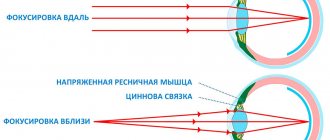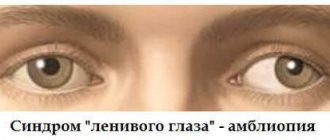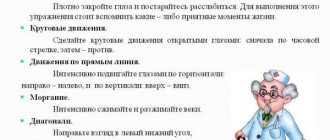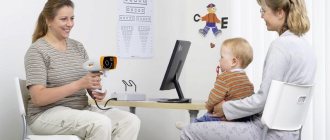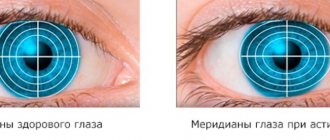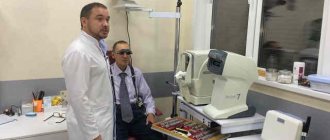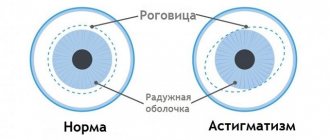Symptoms
Concentrating vision on an object near or far is called accommodation. This ability is given to a person by the ciliary muscle, which moves the lens forward or backward, due to which the image is focused on the retina. In case of prolonged constant movement of the muscle, overstrain occurs. Its partial atrophy and spasm of accommodation begins. It stops responding sufficiently to the commands of the brain. As a preventive measure, you can use eye exercises for spasm of accommodation.
Symptoms of the disease include the following:
- The quality of vision deteriorates sharply.
- Pain begins in the temples and eyes.
- The body quickly becomes overtired under stress.
- The patient sees a veil in front of him, everything around him splits into two.
- To see a picture in the distance, you need to peer for a very long time.
Contraindications
Sometimes the TAKOV complex cannot be used to treat patients. It is usually not suitable for patients with visual acuity less than 0.1. Also, it cannot be used in patients with improper fixation of the eye, increased convulsive activity, or disruption of the vestibular system. If binocular components of the complex are used, then patients with strabismus of more than 20 should be excluded. Contraindications to the use of the SUCH complex are: age less than 3-4 years, decreased intelligence due to mental illness.
Treatment
False myopia is determined by an ophthalmologist, after which they look for the cause that caused the disease. Its elimination will be included in the complex of health measures. Analysis of work, study, lifestyle contributes to correct diagnosis.
The most effective way to combat the disease is a special set of exercises for the eyes:
- movements of the pupils to the right, left, up, down;
- the eyeballs describe a circle to the right, to the left;
- sharp, dynamic blinking (squeezing and opening eyelids);
- focusing vision on the bridge of the nose - place a finger on the bridge of the nose and look at it;
- diagonal movements (lower corner on the left, upper corner on the right, and vice versa);
- take a pencil and look at it from a distance, then close up;
- put your hand to the side and look at the tip of your finger, gradually bringing your hand closer to you;
- raise your arm bent at the elbow and look at your fingers without turning your head.
Therapeutic exercises will help relieve eye tension, improve vision, general well-being, and mood:
- A 5 mm paper circle of black or red color is attached to the window, which is looked at for a while, after which the focus is shifted to a distant object outside the window, the patient’s choice. The exercise is done once a day for 5 minutes, for 7 days.
- Concentrate on a finger located at a distance. They bring their finger closer, and then peer at a distant object. This workout will help improve your focus.
- They massage the eyelids.
- Cover the closed eyelids with your palms so that the center of each is at the level of the pupil. There is no need to apply pressure, the eyes should just rest.
Lens muscle training is carried out under the supervision of an ophthalmologist. There are no surgical methods for treating spasm of accommodation, but the doctor may prescribe Atropine drops. After a week's course of treatment, visual acuity returns. But sometimes the effect does not last long, and vision begins to decline even faster. Artificial relaxation of the ciliary muscle does not train it, but makes it weak. Therefore, drug treatment, even drops of Atropine, should be avoided. It is better to do exercises and give your eyes a rest.
The patient can enhance treatment with a balanced diet. It is recommended to eat more foods that contain carotene: dried apricots, carrots, persimmons. It is necessary to include foods rich in vitamin C in your diet: currants, blueberries, lemon.
Vision training - strengthening the extraocular muscles
Now let's look at a set of eye exercises aimed at strengthening the extraocular muscles. So.
Exercise 1
Performed while sitting. Slowly move your gaze from the floor to the ceiling and back, while looking only at your eyes, without turning your head. Repeat the exercise 8-12 times.
Exercise 2
Performed while sitting. Slowly move your gaze to the right, left and back. Repeat 8-10 times.
Exercise 3
Performed while sitting. Slowly move your gaze to the right and up, then to the left and down and back. Now move your gaze along another diagonal - left and up, then right and down and back. Repeat the exercise 8-10 times.
Exercise 4
Performed while sitting. Make circular movements with your eyes in one direction, then in the other. Repeat 4-6 times.
Rehabilitation and prevention
In order to restore vigilance, you must follow some rules:
- When reading and writing, the place must be well lit, for which a 75-watt lamp is used.
- Maintain a distance of less than 33 cm between the eyes and a book or notebook.
- They walk in the fresh air every day.
- Make sure that the food is complete.
- Provide vitamins necessary for eye health (if possible, vitamins should be in foods, not in tablets).
Sometimes it is better to give up reading, watching TV for a while, and reduce physical activity (especially if the physical activity is significant, there should be light physical activity). A healthy lifestyle, providing the body with all the necessary elements, will strengthen the nervous system and immunity. And this is the first step to feeling great.
Spasm of accommodation is detected by an ophthalmologist. Patients undergo a comprehensive examination: visometry, determination of refraction, determination of accommodation reserves. Remember that your child must be examined by an ophthalmologist at least once a year, even if there are no vision complaints.
When a spasm of accommodation is detected, to establish its possible causes, the patient is referred for consultation to a pediatrician or therapist (depending on age), an ENT doctor, a neurologist, and their study or work schedule and daily routine are clarified. If one of the causes leading to a spasm of accommodation is identified, its elimination is part of the complex treatment. At the same time, the ophthalmologist treats the spasm of accommodation. The basis for the treatment of accommodation spasms (false myopia) includes a complex of health and hygienic measures.
There are no surgical treatments for spasm of accommodation. Very often, ophthalmologists prescribe eye drops that expand the icon (atropine or its analogues) to relieve spasm. These drops have a relaxing effect on the ciliary muscle. Indeed, after a course of drops (usually lasting 7-10 days), the spasm of accommodation completely disappears. This achieves the positive effect of improving visual acuity. But how long-lasting is this effect? The observations of ophthalmologists are disappointing: some time after a course of drops, the deterioration in vision acuity progresses even faster. This happens because forced relaxation of a muscle does not train it, but rather weakens it.
Exercises
Exercises to relieve eye strain:
- Blink rapidly for 1-2 minutes. Then close your eyes and lightly massage your eyelids with your fingertips for one minute. This exercise relaxes the eye muscles and improves blood circulation.
- Close your eyes tightly and then open your eyes. Repeat 8-10 times. Rotate your eyes first in one direction and then in the other direction - 6-8 times. Take a pencil and look at its tip, then bringing it closer by 5-7 centimeters, then moving it away at arm's length. Do this exercise 6 times.
- While standing, move your right hand forward 25-30 cm and look with both eyes at the tip of your index finger for 5-7 seconds. Slowly move your finger closer, without taking your eyes off it, until it begins to double. Repeat 6-8 times.
- Move your half-bent arm to the right side and look at your fingers. Without turning your head, watch your fingers, slowly moving them from right to left, and then in the opposite direction. Repeat 10-12 times.
Gymnastics
- Stick a red or black dot with a diameter of 5 mm on the window. Look at it for a few minutes, then turn your gaze to some distant object outside the window. Do this exercise for 5 minutes once a day for a week.
- Extend your hand forward with your index finger straightened, fixing your gaze on it. Continuing to look at your finger, slowly bring it to your nose. Shift your gaze to a distant object. Repeat the exercise several times. This exercise helps improve your ability to see equally well both at a distance and at close range.
- Sit on a chair. Take a comfortable position. Close your eyes and cover them with your palms so that the middle of your palms is above your eyes (right over right, left over left). Do not put pressure on your eyes under any circumstances. Imagine yourself in a comfortable environment. This exercise helps to quickly relax the eyes. If you perform this exercise 2-3 times a day for 10-15 minutes, your vision will improve significantly.
Drops
To eliminate this problem, ophthalmologists prescribe eye drops that dilate the pupil (Tropicamide, Midriacil, etc.). They relax the ciliary muscle. The course of treatment with drops ranges from a week to a month. Thanks to the drops, the spasm of accommodation goes away, but it may well return again. To prevent this, it is necessary to use alternative treatment methods:
- performing special exercises for the eyes;
- physical activity (swimming, cycling);
- massage, since one of the reasons for the appearance of false myopia may be scoliosis;
- taking vitamins for vision containing lutein (for adults - “Lutein Complex”, for children from 7 years old - “Lutein Complex for Children”).
Spasm of accommodation can be successfully treated with laser therapy. The effectiveness of this method increases in the treatment of the above-described vision pathology in childhood. The laser beam, acting on the eye, starts the process of inhibiting the pathological process, improves visual functions, and stimulates vision restoration.
A device that can be used at home is “Sidorenko Glasses” - it has a multifactorial effect on the eye and surrounding tissues - it improves blood supply to the tissues, and “massage” of the pupil due to light pulses leads to contraction and relaxation of the ciliary muscle, which helps relieve spasm of accommodation. Unlike drops, Sidorenko Glasses are approved for use from the age of 3 years and have no side effects.
All our lives we are in the process of learning: from kindergarten, then school, higher educational institutions. It is at this time that the eyes are most often exposed to stress and the chances of vision loss increase, diseases such as myopia or farsightedness and astigmatism occur. The development of myopia is preceded by another disease - a spasm of accommodation, which can last a long time - from several months to a year. And if you do not provide a child or an adult with timely help and do not start treatment, myopia begins to develop.
Spasm of accommodation is also called false myopia, as well as tired eyes syndrome. This disease manifests itself as a result of prolonged eye strain, when it is necessary to constantly peer into the distance, and then suddenly change the position of the eyes to a close distance. How familiar this is to every person from school or college. The teacher writes on the board, and the students need to see what is written and follow the instructions. Therefore, when a child develops a spasm of accommodation, headaches and fatigue begin accordingly. To prevent the development of myopia, it is necessary to identify a spasm of accommodation in time and carry out immediate treatment. It is also worth paying attention to preventive methods to keep your eyes in good condition. Gymnastics for the eyes during spasm of accommodation is indicated for every person (not only schoolchildren or students) who suffers from rapid visual fatigue.
Group of exercises for blood circulation and intraocular fluid
Exercise 1
It must be done while sitting. Close the eyelids of both eyes for 3-5 seconds. Then open them for the same amount of time. Repeat this exercise 6-8 times.
Exercise 2
Performed while sitting. Blink both eyes quickly for 10-15 seconds. Repeat 6-8 times.
Exercise 3
Performed while sitting. Close the eyelids of both eyes and use your index fingers to massage them in a circular motion for one minute. You will feel your fatigue go away and your head clearer a little.
Exercise 4
Like the first three, it is performed while sitting. Close your eyes and use three fingers of each hand to lightly press your eyeballs through your upper eyelids for 1-3 seconds. Repeat the exercise 3-4 times. Just don't put too much pressure on your eyes, otherwise you may feel dizzy.
Exercise 5
Performed while sitting. Press the index fingers of each hand onto the skin of the corresponding brow ridge and close your eyes. While holding the skin, your fingers should provide resistance to the muscles of the upper eyelids and forehead. Repeat the exercise 6-8 times.
What is a spasm of accommodation and the main symptoms
Accommodation is the ability of the eyes to focus on objects far and near. To see an object in the distance through binoculars, or to see it close up, we adjust the sharpness. The optical system of the human eye also contains a device that can bring objects closer or further away - this is the ciliary muscle. This muscle moves the lens back or forward to focus the image on the retina.
Imagine, if you constantly tense and relax this muscle, will it soon get tired and stop responding to the command to focus? The more the eye strains to change the focal length, the faster partial atrophy of the ciliary muscle will develop and a spasm of accommodation will begin - the eye will not focus at a close distance. Among the preventive methods of training the eye muscle is eye gymnastics for spasm of accommodation.
Symptoms of accommodation spasm:
- the quality of distance vision drops sharply;
- headaches, in the temples, in the eyes;
- the eye gets tired quickly under stress;
- double vision, blurred vision;
- you have to look for a long time to see the image.
Causes of accommodation spasm:
- frequent looking at distant objects;
- close working distance is too short;
- A blinding light is directed at the eyes and acts as an irritant;
- lack of a proper daily routine, not enough rest, constant workload;
- unbalanced diet;
- lack or insufficient amount of walking in the fresh air;
- during neuroses, hysteria, and cranial injuries.
Indications for use
The TAKOV complex is used for:
- Decreased vision due to refractive error;
- Accommodation disturbances, including accommodation spasm;
- Amblyopia;
- Binocular vision disorder;
- Asthenopia, increased visual tension.
For rehabilitation, the complex is used after ophthalmological operations, including correction of optical defects. Treatment should be prescribed by a doctor specializing in pleopto-orthoptic therapy. When all components of the complex are used together and alternately, versatile visual stimulation occurs.
The TAKOV complex can be used in adult patients and in children over 3-4 years of age. The complex (as well as its individual components) is used in the treatment of ophthalmological patients. They can be combined with other devices for pleopto-orthoptic therapy. To use the complex correctly and harmlessly, you must follow your doctor’s recommendations. It is also important to regularly undergo timely medical examinations. The TAKOV complex is also suitable for use for preventive purposes. Using its components, the dynamics of visual function can be assessed.
Treatment methods for spasm of accommodation
This disease can only be diagnosed by a qualified ophthalmologist, who, after identifying it, refers it to a therapist and pediatrician for examination (if the child has the disease). Initially, what a specialist can do is advise changing your lifestyle and work. Then glasses are selected to relieve the ciliary muscle. Follow a regimen of exercise and rest: do exercises every 30 minutes. Then, under the supervision of a doctor, exercises are carried out to train the muscle, and it is recommended to perform basic gymnastics at home.
Composition of the accommodation training complex
The complex includes several devices:
- Apparatus for training oculomotor function and accommodation (TAK-6);
- Apparatus for training the coordinated action of the eye and hand (TVO-1);
- Apparatus for analysis and training of accommodation (AKR-1);
- Kit for eye pattern stimulation (PSR-1);
- Kit for restoration of binocular vision (BZR-1);
- Kit for pattern stimulation of vision with processing program (PSK-1);
- Kit for restoring binocular vision, accompanied by a processing program (БЗК-1).
All devices included in the complex are also suitable for independent use.

